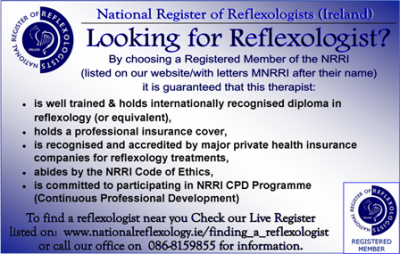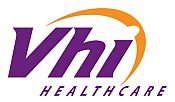LOOKING FOR REFLEXOLOGIST? >>CLICK HERE>>

REFLEXOLOGY TREATMENTS ON CHILDREN (Case Studies)
Foreword
I was under the impression that children might respond well to reflexology because they have not yet learned our deep cultural dislike of being touched. They are still at home in their bodies and therefore they might actually have no objections to a soothing touch that might help as well. I suppose I wasn't far wrong when I began 6 treatments each on Shane and Siobhan (names changed) in Ennis, Co. Clare, June 2007.
I'm also a firm believer in trying to encourage alternative approaches for children's health because anything that can reduce GP visits has to be a welcome development, especially for parents with children who have recurring health issues or minor complaints that could be treated with reflexology.
Reflexology Treatment on Children Case Study #1
Case study 1 involved a 4-year old boy called Shane presenting with asthma, eczema and some digestive issues. Shane was a charming little ‘power ranger' to treat as he had never experienced anything like reflexology before. He was happy enough with the fuss that was made of him and he enjoyed the magic of his reclining chair and the promise of a reward at the end. The fact that only his sandals had to be removed also made the whole experience quite painless and there were no needles and no tablets, just some lady rubbing his feet!
I began a full reflexology treatment on Shane and his mother and I were at pains to teach Shane how to breathe effectively throughout the session and how to sustain that level of breathing. He was particularly sensitive to the ‘combing' relaxation technique and he remembered this at each subsequent session. There was a lot of learning in each treatment for Shane as he is not one to sit still for long periods - and why should he, as he is only 4 years of age? He was partial to wincing quite a bit during the very first session and pulling his feet away, and moving around from side to side.
This pattern did start to subside a little as treatments went on and as he became more familiar with me and with the routine. He also remembered to breathe whenever he anticipated a particularly intense reflex point.
All in all I found him to be quite responsive to the treatments with particular discomfort being experienced at the following reflex points:
• Trachea (and a little at the tonsils) on both feet
• Lungs area on both feet
• Diaphragm on both feet
• Illeocaecal valve
• Large intestine
• A little at the shoulder joints
• Kidneys
• Pituitary gland
I recommended that the steam inhalation method be used on an ongoing basis to aid his breathing at night while he is asleep as he is prone to coughs and a runny nose. Also, yoga breathing methods could be encouraged to strengthen his lungs and diaphragm in the long term. Finally, I recommended finding a good aroma-therapist to develop some asthma massage formulas for Shane.
Fortunately for Shane he avoids wheat and dairy most of the time, and fizzy drinks and artificial additives and preservatives some of the time and this is a great start as diet is vital in treating asthma. Shane is also great for drinking water, which I continued to encourage after each treatment.
In terms of Shane's eczema, I focused on the following systems during his reflexology treatments:
• Endocrine system
• Nervous system
• Elimination - lungs, bowel, kidneys
• Lymphatic system
Reflexology Treatment on Children Case Study #2
Case study 2 involved an 11-year old girl called Siobhan presenting with some abdominal cramps, headaches and a minor shoulder joint complaint.
Siobhan, a shy girl, was a joy to work on as she was as still as a mouse and was quietly intrigued by what I was doing. She also worked really hard on continuous mindful breathing throughout the treatments, which is a great habit to develop young.
Siobhan was consistent in her positive response to the treatments and when she first arrived she was experiencing discomfort at the following reflex points:
• Shoulder joint on right foot
• Mid-back area on both feet
• Lower back area on both feet
• Stomach area on left foot
• Around uterus on both feet
• Urinary tract & bladder on left foot
• Illeocaecal valve
• Large intestine
• Kidneys
• Pituitary gland
The Illeocaecal valve became an issue for both children and when I asked both mothers it emerged that there had been some constipation recently. The illeocaecal valve lies between the small intestine and the large intestine and its function is to prevent the backward flow of the contents of the large intestine into the ileum. Reflexology and diet combined seem to work on constipation quite well and it wasn't a reflex point that was obviously sore at each subsequent session with Shane or Siobhan.
Siobhan is from Clare and therefore it's her destiny as a Clare woman to learn the fiddle! She has been learning it for the last 2 years and it may be contributing to the slight discomfort she sometimes feels at her right shoulder joint.
The shoulder joint is a freely moveable joint and therefore it can be vulnerable and prone to tendonitis. Tendonitis is the gradual increase of pain in movement and is also known as Repetitive Strain Injury.
This occurs when certain muscles and tendons are overused in a particular repetitive exercise and those most at risk are computer users or typists, musicians, carpenters and nurses.
In Siobhan's case, it is not that severe YET but I encouraged her to think about the following in terms of preventing the joint from ever falling prone to tendonitis:
1) Alternating repetitive movements with other movements will help reduce the risk.
2) Warming up before the repetitive exercise (i.e. before the music lesson or music practice) and winding down a little afterwards.
3) If the pain persists - consider using heat treatments at the source (castor oil). This old herbal remedy is very popular and very successful.
"Of all the things that happen to our body, poor posture is one of the easiest to correct" - Doctor Stanton (The Mission, 1995). The treatment goals for correcting postural problems should include restoring range of motion, increasing flexibility and strengthening weak muscles. Reflexology can improve posture by focusing on the following systems; nervous, respiratory, skeletal and muscular systems.
The abdominal cramps that Siobhan is experiencing may be linked to puberty and the onset of her menstrual cycles. This may also explain her occasional change in moods and headaches as reported by her mother. Pre-menstrual syndrome begins at, or, after ovulation and the symptoms include a wide variety of physical and psychological symptoms persisting for up to 14 days. An imbalance between oestrogen and progesterone levels may be the cause.
But for a pubescent girl who has never had a menstrual cycle before the symptoms can be quite pronounced at first.
Here are some of the symptoms:
1. Abdominal bloating.
2. Breast tenderness.
3. Fluid retention.
4. Discomfort.
5. Irritability, depression, tension, heightened emotional sensitivity.
Treatments that are recommended include:
• Evening primrose oil
• Vitamin B6 & magnesium.
• Herb - agnus castus
• Avoid salt, sugar, caffeine, chocolate
In my reflexology sessions with Siobhan I focused on:
• Relaxation techniques
• Solar Plexus
• Nervous & Endocrine systems - in particular the pituitary gland, uterus and ovaries.
Conclusion
I found the reflexology treatments on both children to be very interesting for me as a therapist as the sessions provided me with a map or representation of their current health status. I also believe that reflexology on children is appropriate and in some cases ideal for minor ailments.
In the case of Shane's asthma, reflexology (and continuous but gentle work on his respiratory system reflex points) can complement other interventions. I think combined approaches will strengthen his lungs and diaphragm to function more efficiently and enhance his experiences as a young and growing boy. It is encouraging to know that asthma often stops at puberty.
The one obvious triumph for me in doing these treatments on children was the opportunity I had to continuously encourage these 2 children to drink water, especially after the treatments, but all of the time as well. By failing to drink a sufficient quantity of good quality water every day you are allowing your mind and body to work less well and less efficiently.
I'll conclude with this great list of reasons for drinking water - in children's eyes water may not be a great substitute for fizzy drinks but maybe they'll change their minds in time!
10 Reasons to Drink Water:
1. Water is absolutely essential to the human body. A person can live for about a month without food, but only for about a week without water.
2. Water helps to maintain a healthy body weight by increasing metabolism and regulating appetite.
3. Water leads to increased energy levels. The most common cause of daytime fatigue is actually mild dehydration.
4. Drinking adequate amounts of water can decrease the risk of certain types of cancers, including colon cancer, bladder cancer, and breast cancer.
5. For a majority of sufferers, drinking water can significantly reduce joint and / or back pain.
6. Water leads to overall greater health by flushing out wastes and bacteria that can cause disease.
7. Water can prevent and alleviate headaches.
8. Water naturally moisturises the skin. It also ensures proper cellular formation underneath the layers of skin to give it a healthy, glowing appearance.
9. Water aids in the digestion process and prevents constipation.
10. Water is the primary mode of transportation for all nutrients in the body and is essential for proper circulation.*
Lorraine Hughes, MNRRI
References & Bibliography:
1) Alexander, Jane. Live Well - The Ayurvedic Way to Health and Inner Bliss. HarperCollins Publishers. 2001.
2) Wright, Janet. Reflexology and Acupressure. Octopus Publishing Group. 1999
3) www.uthscsa.edu The Mission, Exercise help some posture problems. 1995.
*www.arethusabottledwater.com Why Drink Water. 2007.


 Our Objectives
Our Objectives CPD Programme
CPD Programme





